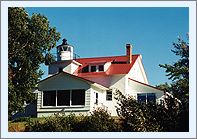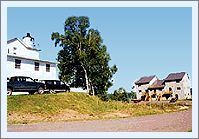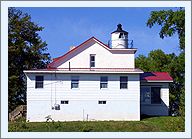 |
 |
 |
| Click thumbnails to view enlarged versions | ||
| Eagle River Light | Seeing The Light |
|
|
|
|
Historical Information To guide maritime traffic into this busy harbor, Congress appropriated $6,500 for the construction of a light at Eagle River on September 28, 1850, and while a site for the station was selected that year, it took until the Michigan Legislature's 1853 session to obtain a clear title to the site, allowing work to commence. While Lighthouse Board records indicate that the contractor was actively working at the site in 1855, construction was not completed until 1857. The contractor's work was evidently poor, since the District Inspector refused acceptance of the station due to it's not being constructed "in conformity to the terms of the contract." While the exact nature of the deficiencies were undefined, the contractor evidently undertook the appropriate modifications, since the Inspector subsequently accepted the structure after a second inspection.
Evidently, the original concern for the station's construction were well-founded, as in 1867 large cracks were found to have developed at the base of the tower. When these cracks enlarged noticeably over the following winter, the District Inspector reported that the entire structure was in danger of collapse, and needed immediate repair or replacement. Congress appropriated $14,000 for the station's replacement on March 3, 1869, and while plans were put in place for the station's replacement the following year, the project was canceled when the appropriated funds were recalled by a financially strapped Congress on July 12, 1870.
With every boom, there is an inevitable bust, and Eagle River was no exception. Reacting to rapidly declining copper prices, the Cliff Mine closed its doors in 1873, and Eagle River's once busy docks sat rotting. Without maritime traffic, the river mouth became silted to a point that the harbor became inaccessible to all but the shallowest draft vessels. However, serving as the only light between the Keweenaw Waterway and Eagle Harbor, the Eagle River light station continued to serve duty as a marker for vessels coasting the shore of the peninsula. Finally, in 1884 the much needed work was conducted at the station, with the walls rebuilt and the entire keepers dwelling renovated. In its annual report for that year, the Eagle River station was once again reported as being "in good order." By 1890, virtually the only vessel making its way into the decaying Eagle River harbor was the lighthouse tender on its annual supply trips, and the Lighthouse Board was well aware of the futility of continuing to maintain a light to protect the non-existent harbor. In its 1892 annual report, the Lighthouse Board noted that traffic patterns on the lake had changed, and that eastbound vessels were making a turn off Sand Hills, some seven miles to the west of Eagle River, and approximately midway between the coast lights of Ontonagon and Eagle Harbor. With the treacherous Sawtooth Reef located just offshore at this point, the Board recommended to Congress that $20,000 be appropriated to decommission the light at Eagle River, and construct a new coast light at Sand Hills.
The Board continued to request the $38,000 in every subsequent annual report through 1907, when it temporarily abandoned the project, and ceased to mention the planned station. The Eagle River Light Station was
decommissioned in 1908, and with its buildings no longer
serving any purpose to maritime interests, Major Charles Keeler of the
Eleventh Lighthouse District determined that it would be advantageous to
offer the property for sale at public auction. An auction was held on
Monday, August 2 of that year, at which the property was purchased by
John Vertin of Calumet with his winning bid of $925.00, making the Eagle
River light the first in the Keweenaw to pass into private ownership. As a result of early deactivation in 1908, this lighthouse was sold into private ownership early in the game. The various owners through the years have maintained the building in excellent condition.
Sadly, a four-unit condominium has been built on the small strip of land between
the low bluff on which the lighthouse sits and the lakeshore. Being three stories high,
this condominium serves as a modern intrusion to the station's
historically commanding view of the lake. |